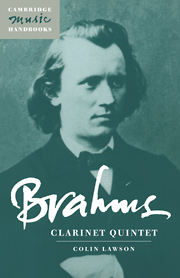Book contents
- Frontmatter
- Contents
- List of illustrations
- Preface
- 1 The nineteenth-century clarinet and its music
- 2 Brahms and the orchestral clarinet
- 3 Brahms's chamber music before 1891
- 4 The genesis and reception of the Clarinet Quintet
- 5 Design and structure
- 6 Performance practice
- 7 The legacy of Brahms's clarinet music
- Appendix 1 A list of Brahms's chamber music
- Appendix 2 A review of the first London performance,The Times,29 March 1892
- Appendix 3 The mechanism of Mühlfeld's Baermann-Ottensteiner clarinets
- Notes
- Select bibliography
- Index
Appendix 2 - A review of the first London performance,The Times,29 March 1892
Published online by Cambridge University Press: 05 June 2012
- Frontmatter
- Contents
- List of illustrations
- Preface
- 1 The nineteenth-century clarinet and its music
- 2 Brahms and the orchestral clarinet
- 3 Brahms's chamber music before 1891
- 4 The genesis and reception of the Clarinet Quintet
- 5 Design and structure
- 6 Performance practice
- 7 The legacy of Brahms's clarinet music
- Appendix 1 A list of Brahms's chamber music
- Appendix 2 A review of the first London performance,The Times,29 March 1892
- Appendix 3 The mechanism of Mühlfeld's Baermann-Ottensteiner clarinets
- Notes
- Select bibliography
- Index
Summary
On 28 March 1892 at one of the ‘Popular Concerts’ at St James's Hall, Richard Mühlfeld introduced Brahms's Clarinet Quintet to London, with Joseph Joachim, Louis Ries, Ludwig Straus and Alfredo Piatti. The audience included Grove, Parry and Stanford. On that occasion Joachim, ‘apparently to counterbalance the extreme novelty of the opening piece’, gave as his solos the Barcarolle and Scherzo by Spohr, with ‘his own pretty Romance in B flat’ as an encore. The final concerted number was Mozart's Trio in B flat, with pianist Miss Agnes Zimmermann, who also played Schumann's G minor Sonata. Mile Gherlsen, a pupil of Georg Henschel, sang Mozart's ‘Deh vieni non tardar’ and Brahms's ‘Feldeinsamkeit’ and ‘Vergebliches Ständchen’ (the last in a French translation); the critic observed that ‘her agreeable voice and good method have been more favourably exhibited on former occasions’.
The chief event of the present musical season took place last night in the production, in circumstances the most favourable that can be imagined, of the quintet for clarinet and strings lately written by Brahms. In the case of a work of such incontestable genius it is useless to withhold expressions of admiration until after a second hearing; the form in which it is written is, besides, so clear that its general scope and drift need hardly overtax the powers of the merest tyro to appreciate. The quality which first strikes the hearer is that of homogeneity.
- Type
- Chapter
- Information
- Brahms: Clarinet Quintet , pp. 89 - 90Publisher: Cambridge University PressPrint publication year: 1998



